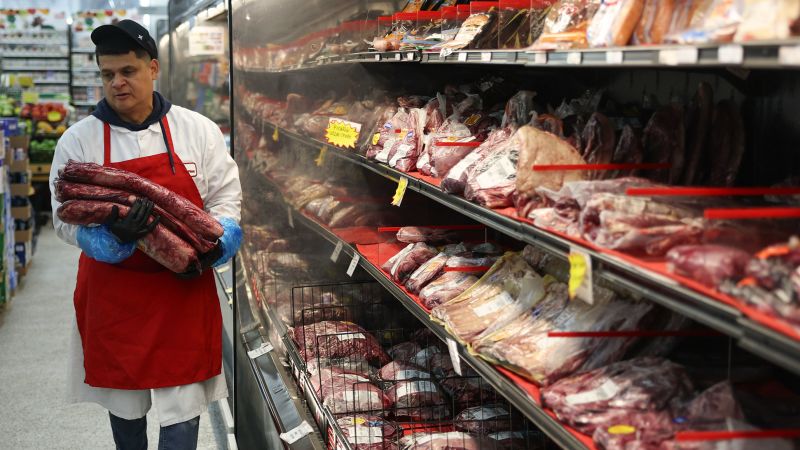Listen to the article
Trump’s Claims on Grocery Prices Contradict Federal Data
President Donald Trump has repeatedly claimed that grocery prices have declined during his second term, with beef being the only food product that has become more expensive. However, federal data and economic experts paint a starkly different picture of the current food price landscape.
“Groceries are down except for the beef, which I’ll get down too,” Trump stated in a recent speech in Tokyo. He has echoed this sentiment across multiple platforms, including interviews with Fox News and CBS, as well as during a White House appearance where he insisted, “We only have one thing, beef.”
Analysis of Consumer Price Index (CPI) figures shows that Trump’s assertions about grocery prices are incorrect on both counts. Not only are overall grocery prices higher than when he took office in January, but beef is far from being the only product that has seen price increases.
According to the latest CPI data, average U.S. grocery prices in September were 1.4% higher than in January 2025, when Trump returned to office. Compared to September 2024 under former President Biden, grocery prices have increased by 2.7%. The trend appears to be accelerating, with the 0.6% increase from July to August representing the largest month-to-month jump in three years, followed by another 0.3% increase from August to September.
“The president’s claims about grocery prices don’t align with the government’s own data,” said David Ortega, a food economist and professor at Michigan State University. “While it’s true that beef prices have risen to record highs, they’re far from the only category seeing increases.”
The data reveals price increases across five of the six major grocery categories tracked by the CPI. From January to September, the “meats, poultry, fish, and eggs” category rose by 4.5%, while “nonalcoholic beverages and beverage materials” increased by 2.8%. “Cereals and bakery products” saw a 1.4% increase, “fruits and vegetables” rose by 1.3%, and “other food at home” increased by 0.8%. Only “dairy and related products” showed a modest decline of 0.2%.
Economic experts point to two key Trump administration policies as contributing factors to these rising food costs. First, the implementation of broad tariffs on imported goods, including food products and packaging materials, has driven up prices for both domestic and international products. Second, the administration’s crackdown on undocumented immigrants, who comprise a significant portion of the U.S. agricultural workforce, has affected labor costs and supply chains.
The impact of these policies is particularly evident in certain product categories. While uncooked ground beef prices have indeed increased by 14.2% since January, coffee has seen an even larger price jump of 15.3%. As an almost entirely imported product now subject to significant tariffs, coffee exemplifies how trade policies can impact grocery costs. Similarly, bananas, another predominantly imported product now facing tariffs, have experienced a 7.9% price increase since January.
While grocery prices typically rise over time due to various economic factors beyond presidential control, the current data contradicts Trump’s repeated assertions that prices are decreasing. The evidence shows that American consumers are facing higher costs across numerous food categories, with policy decisions potentially exacerbating these inflationary pressures.
As Ortega noted, “The reality is that prices for many everyday grocery items have increased in recent months, and tariff-related cost increases are now feeding through to consumers.”
Fact Checker
Verify the accuracy of this article using The Disinformation Commission analysis and real-time sources.




15 Comments
Interesting fact check. It seems Trump’s claims about grocery prices don’t align with the actual data. I wonder what factors are driving the increases across multiple food categories, not just beef.
Yes, the CPI data paints a different picture than Trump’s assertions. Grocery inflation appears to be more widespread than just beef prices.
Interesting to see the discrepancy between Trump’s claims and the CPI data. I wonder if there are regional variations in grocery price trends that could explain the difference.
Good point. Examining potential regional differences could provide more nuance to the overall picture. Nationwide averages may not capture localized price dynamics.
It’s concerning to see the discrepancy between Trump’s statements and the actual CPI data on grocery prices. Accurate information is critical, especially on issues that directly impact household budgets.
This is an important issue for consumers, who are feeling the pinch of higher food costs. It’s concerning to see the President make claims that don’t match the economic data.
Agreed. Transparent and accurate information on price trends is crucial, especially for essential goods like groceries. Hopefully policymakers can address the underlying factors driving these price increases.
This highlights the importance of verifying claims, even from high-profile political figures. Fact-checking helps ensure the public has accurate information on important economic issues.
Exactly. Relying on reliable data rather than unsubstantiated assertions is crucial for making informed decisions, whether as a consumer or a policymaker.
The article highlights how Trump’s statements contradict the federal data on grocery prices. It’s important for leaders to ground their claims in facts, especially on issues that directly impact people’s wallets.
Absolutely. Factual analysis is key, rather than making broad generalizations. This kind of fact-checking helps hold public figures accountable.
This fact check underscores the need for leaders to be accountable and transparent about economic conditions. Making claims that don’t align with the data erodes public trust.
Agreed. Fact-based analysis is essential for informing policies and decisions that affect people’s daily lives. Dismissing the data in favor of rhetoric is problematic.
I’m curious to see what specific factors are driving the price increases across different grocery items, beyond just beef. Supply chain disruptions, inflation, or other economic forces?
Good point. A deeper dive into the underlying causes would provide more context. Isolating the various factors impacting grocery prices is important for developing effective policy responses.